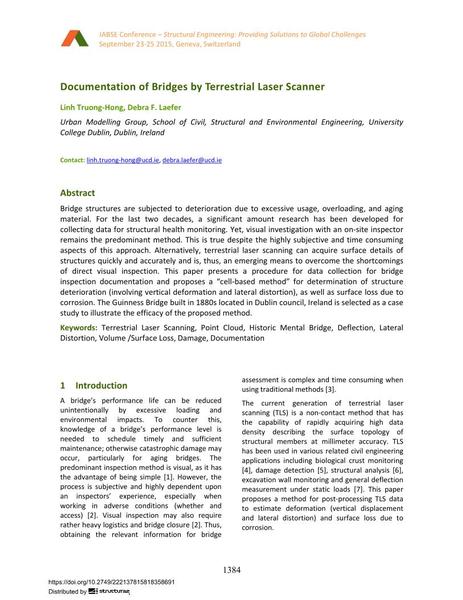Documentation of Bridges by Terrestrial Laser Scanner

|
|
|||||||||||
Détails bibliographiques
| Auteur(s): |
Linh Truonghong
(Urban Modelling Group, School of Civil, Structural and Environmental Engineering, University College Dublin, Dublin, Ireland)
Debra F. Laefer (Urban Modelling Group, School of Civil, Structural and Environmental Engineering, University College Dublin, Dublin, Ireland) |
||||
|---|---|---|---|---|---|
| Médium: | papier de conférence | ||||
| Langue(s): | anglais | ||||
| Conférence: | IABSE Conference: Structural Engineering: Providing Solutions to Global Challenges, Geneva, Switzerland, September 2015 | ||||
| Publié dans: | IABSE Conference Geneva 2015 | ||||
|
|||||
| Page(s): | 1384-1391 | ||||
| Nombre total de pages (du PDF): | 8 | ||||
| Année: | 2015 | ||||
| DOI: | 10.2749/222137815818358691 | ||||
| Abstrait: |
Bridge structures are subjected to deterioration due to excessive usage, overloading, and aging material. For the last two decades, a significant amount research has been developed for collecting data for structural health monitoring. Yet, visual investigation with an on-site inspector remains the predominant method. This is true despite the highly subjective and time consuming aspects of this approach. Alternatively, terrestrial laser scanning can acquire surface details of structures quickly and accurately and is, thus, an emerging means to overcome the shortcomings of direct visual inspection. This paper presents a procedure for data collection for bridge inspection documentation and proposes a “cell-based method” for determination of structure deterioration (involving vertical deformation and lateral distortion), as well as surface loss due to corrosion. The Guinness Bridge built in 1880s located in Dublin council, Ireland is selected as a case study to illustrate the efficacy of the proposed method. |
||||
